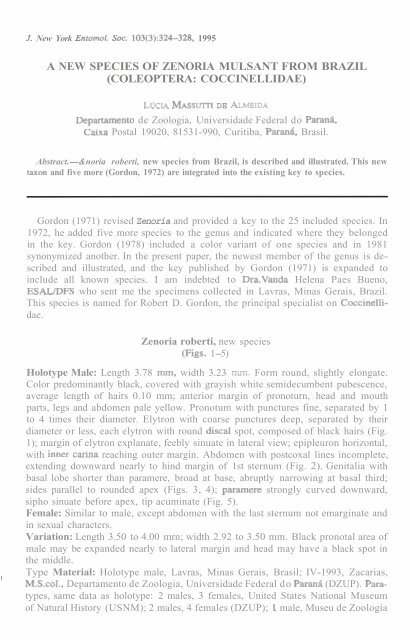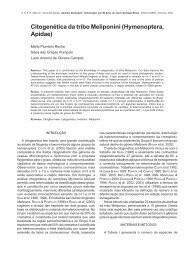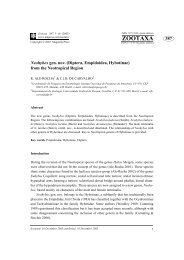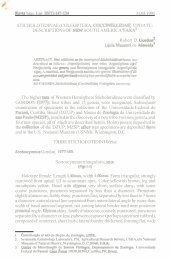coleoptera: coccinellidae - Departamento de Zoologia - UFPR
coleoptera: coccinellidae - Departamento de Zoologia - UFPR
coleoptera: coccinellidae - Departamento de Zoologia - UFPR
You also want an ePaper? Increase the reach of your titles
YUMPU automatically turns print PDFs into web optimized ePapers that Google loves.
J. New York Entomol. Soc. 103(3):324-328, 1995<br />
A NEW SPECIES OF ZENORIA MULSANT FROM BRAZIL<br />
(COLEOPTERA: COCCINELLIDAE)<br />
LOCIA M~ssurn DE ALMEIDA<br />
<strong>Departamento</strong> <strong>de</strong> <strong>Zoologia</strong>, Universida<strong>de</strong> Fe<strong>de</strong>ral do Paranl,<br />
Caixa Postal 19020, 81531-990, Curitiba, Paranl, Brasil.<br />
Abstract.-&noria roberti, new species from Brazil, is <strong>de</strong>scribed and illustrated. This new<br />
taxon and five more (Gordon, 1972) are integrated into the existing key to species.<br />
Gordon (1971) revised Zenoria and provi<strong>de</strong>d a key to the 25 inclu<strong>de</strong>d species. In<br />
1972, he ad<strong>de</strong>d five more species to the genus and indicated where they belonged<br />
in the key. Gordon (1978) inclu<strong>de</strong>d a color variant of one species and in 1981<br />
synonymized another. In the present paper, the newest member of the genus is <strong>de</strong>-<br />
scribed and illustrated, and the key published by Gordon (1971) is expan<strong>de</strong>d to<br />
inclu<strong>de</strong> all known species. I am in<strong>de</strong>bted to Dra.Vanda Helena Paes Bueno,<br />
ESALDFS who sent me the specimens collected in Lavras, Minas Gerais, Brazil.<br />
This species is named for Robert D. Gordon, the principal specialist on Coccinelli-<br />
dae.<br />
Zenoria roberti, new species<br />
(Figs. 1-5)<br />
Holotype Male: Length 3.78 mrn, width 3.23 mm. Form round, slightly elongate.<br />
Color predominantly black, covered with grayish white semi<strong>de</strong>cumbent pubescence,<br />
average length of hairs 0.10 mm; anterior margin of pronoturn, head and mouth<br />
parts, legs and abdomen pale yellow. Pronotum with punctures fine, separated by 1<br />
to 4 times their diameter. Elytron with coarse punctures <strong>de</strong>ep, separated by their<br />
diameter or less, each elytron with round discal spot, composed of black hairs (Fig.<br />
1); margin of elytron explanate, feebly sinuate in lateral view; epipleuron horizontal,<br />
with inner carina reaching outer margin. Abdomen with postcoxal lines incomplete,<br />
extending downward nearly to hind margin of 1st sternum (Fig. 2). Genitalia with<br />
basal lobe shorter than paramere, broad at base, abruptly narrowing at basal third;<br />
si<strong>de</strong>s parallel to roun<strong>de</strong>d apex (Figs. 3, 4); paramere strongly curved downward,<br />
sipho sinuate before apex, tip acuminate (Fig. 5).<br />
Female: Similar to male, except abdomen with the last sternum not emarginate and<br />
in sexual characters.<br />
Variation: Length 3.50 to 4.00 mrn; width 2.92 to 3.50 mm. Black pronotal area of<br />
male may be expan<strong>de</strong>d nearly to lateral margin and head may have a black spot in<br />
the middle.<br />
Type Material: Holotype male, Lavras, Minas Gerais, Brasil; IV-1993, Zacarias,<br />
' M.S.col., <strong>Departamento</strong> <strong>de</strong> <strong>Zoologia</strong>, Universida<strong>de</strong> Fe<strong>de</strong>ral do Paranl (DZUP). Para-<br />
types, same data as holotype: 2 males, 3 females, United States National Museum<br />
of Natural History (USNM); 2 males, 4 females (DZUP); 1 male, Museu <strong>de</strong> <strong>Zoologia</strong>
1995 A NEW ZENORIA FROM BRAZIL 325<br />
Figs. 1-5. Zenoria roberti n.sp. Male. 1. habitus. 2. abdomen. 3. genitalia (ventral view).<br />
4. genitalia (lateral view). 5. sipho.<br />
da Universida<strong>de</strong> <strong>de</strong> SIo Paulo (MZSP); 1 female, S. Caraca (Engenho) 800 m, Minas<br />
Gerais, Brasil, XI-1961, Kloss, Lenko, Martins & Silva col. (MZSP).<br />
Remarks: This species and 2. patula and Z, serva have similar genitalia: 2. serva<br />
and Z. roberti have the basal lobe shorter than parameres, but roberti has the para-<br />
mere narrow at base; Z. patula has the basal lobe equal in length of paramere and
326 JOURNAL OF THE NEW YORK ENTOMOLOGICAL SOCIETY Vol. 103(3)<br />
the apex of paramere nearly touching apically. The spot pattern on 2. roberti distin-<br />
guishes it from all other members of Zenoria. See Gordon (1971) for genitalia il-<br />
lustrations of the 2. patula and 2. serva.<br />
KEY TO SPECIES OF ZENORIA<br />
The key to the species of ZENORIA in Gordon (197 1) is modified to inclu<strong>de</strong> all<br />
known species.<br />
1.<br />
2.<br />
3.<br />
4.<br />
Dorsal surface uniformly pale yellow or red, without markings ................ 2<br />
Dorsal surface completely dark colored or with a dark color pattern ............. 4<br />
Ventral surface with at least the metasternurn dark brown piceous ... Z pallida Gordon<br />
Ventral surface as pale as the dorsal surface .............................. 3<br />
Length 4.00 mm; elytra yellowish red ..................... Z rodolioi<strong>de</strong>s Crotch<br />
Length 3.40 mm; elytra pale reddish yellow .................. Z pilosula Mulsant<br />
Elytron with 1 to 3 dark, longitudinal vittae .............................. 5<br />
Elytron with dark spots, rings, or entirely dark colored ...................... 6<br />
5.<br />
6.<br />
Elytron with 1 dark, submarginal vina, occasionally with a small median spot between<br />
vitta and suture (in part) .............................. Z subcostalis Mulsant<br />
Elytron with 3 dark longitudinal vittae .................... .Z. ratzeburgi Mulsant<br />
Elytron dark metallic purple; pronotum with anterior margin yellow ............<br />
.................................................<br />
Z.purpureaGordon<br />
Elytron completely black or dark metallic green, only a trace of pale color present at<br />
humeral or apical angles on some specimens ............................ 18<br />
Elytron with varying color patterns, always with some yellow or red color ........ 7<br />
7. Elytron pale yellow with a small dark median spot; Peru (in part). .............<br />
................................................<br />
.Z variabilis Gordon<br />
Elytron with color pattern not as above ................................. 8<br />
8. Elytron yellow or red with a single dark submarginal band. ................... 9<br />
Elytron with color pattern not as above ................................ 10<br />
9. Length 3.45 mm; last sternum of female entire; Brazil ........ Z. circumcicta Gordon<br />
Length less than 3.10 mm; last sternum of female strongly emarginate; Trinidad (in<br />
part) ............................................ Z. emarginata Gordon<br />
10. Elytra with a single black or metallic green spot occupying disc, outer margins pale<br />
yellow ....................................................... 11<br />
Elytra with color pattern not as above ................................. 16<br />
I I. Length 4.00 rnm; discal elytral spot black ................... Z. <strong>de</strong>licatula Weise<br />
Length less than 3.50 mm; discal elytral spot black or metallic green ........... 12<br />
12. Meso- and metasternum yellow; discal elytral spot metallic green ............. 13<br />
Meso- and metasternum black, discal elytral spot metallic green or black ........ 14<br />
13. Length less than 3.10 mm; Panama (in part) ................. Z. schwarzi Gordon<br />
Length more than 3.35 mm; Brazil ....................... Z. annularis Gordon<br />
14. Discal elytral spot large, leaving only a narrow yellow ring around lateral bor<strong>de</strong>r of<br />
elytra; Trinidad .................................... Z. emarginata Gordon<br />
Discal elytral spot small, leaving H or more of each elytron yellow; not known from<br />
Trinidad ...................................................... 15<br />
15. Discal elytral spot black; male genitalia with basal lobe as long as paramere, a small<br />
tooth at apex of paramere; Peru, Bolivia .................. Z. discoidalis (Kirsch)<br />
Discal elytral spot usually metallic green; male genitalia with basal lobe shorter than<br />
paramere, paramere with a tooth on inner margin before apex; Brazil .... Z crotchi Gordon
1995 A NEW ZENORL4 FROM BRAZIL 327<br />
16. Elytral pattern tricolored, marginal band yellow, middle band black or metallic green,<br />
median spot red ............................................. 17<br />
Elytral color pattern not as above .................................... 19<br />
17. Middle band of elytra black; Brazil .................... Z. tricolor Nunenmacher<br />
Middle band of elytra metallic green; Panama (in part) .......... Z. schwani Gordon<br />
18. Elytra dark metallic green, most of lateral margin and a broad apical area and narrow<br />
sutural margin paler (in part) .......................... Z subcostalis Mulsant<br />
Elytra pale yellow or with a black triangular spot on disc, or pale yellow with a large<br />
dark brown spot occupying most of elytra, broadly yellow post-medially and narrowly<br />
along suture, or with 3 brown areas on the elytron: a large, irregular area near the<br />
lateral bor<strong>de</strong>r just anterior to the middle, a small, round area on the disc not touching<br />
the suture, and an irregular, transverse area on the apical third with touches on the<br />
suture; Peru ....................................... .Z. variabilis Gordon<br />
19. Male with narrow outer margin or elytron yellow; female with last sternum strongly<br />
emarginate (in part) ................................. Z. emarginata Gordon<br />
Male with elytral margins not paler than rest of elytra; female with last stemum not<br />
emarginate ................................................. 20<br />
20. Epipleuron <strong>de</strong>scending externally; female with last stemum carinate medially; Surinam<br />
................................................. Z.cariMtaGordon<br />
Epipleuron horizontal; female with last sternum not carinate ................. 21<br />
21. Elytra dark metallic green, area of dark pubescence on disk not apparent ........ 29<br />
Elytra black, with dark pubescence spot on each elytron or dark pubescence on disk<br />
veryapparent .................................................. 22<br />
22. Length 4.70 mm or more .............................. Z. stellaris (Gorham)<br />
Length less than 4.70 mm ......................................... 23<br />
23. Length more than 4.10 mm, Peru ........................ Z. paprzyckii Gordon<br />
Length equal or less than 4.00 mm ................................... 24<br />
24. Margin of elytron feebly, abruptly explanate, in si<strong>de</strong> view slightly sinuate ....... 25<br />
Margin of elytron broadly, gradually explanate, in si<strong>de</strong> view strongly sinuate ..... 26<br />
25. Male genitalia with basal lobe longer than paramere; basal lobe wi<strong>de</strong> at base .....<br />
.................................................... 2. roberri asp.<br />
Male genitalia with basal lobe equal in length to paramere; basal lobe slen<strong>de</strong>r since<br />
the base .......................................... .Z. revestita Mulsant<br />
26. Male genitalia with basal lobe shorter than or as long as paramere ............. 27<br />
Male genitalia with basal lobe longer than paramere .......................<br />
............................................................ 28<br />
27. Male genitalia with basal lobe equal in length to paramere; length 3.90 mm ......<br />
................................................... Z.patulaGordon<br />
Male genitalia with basal lobe shorter than paramere ...................... 30<br />
28. Paramere with width base, not inflated with roun<strong>de</strong>d apex .......... Z. serva Gordon<br />
Paramere constricted at base, inflated, with curved and pointed apex Z. dozieri Gordon<br />
29. Length 3.30 mm or less; male genitalia with basal lobe wi<strong>de</strong> at base, concealing<br />
parameres in ventral view, gradually evenly narrowed to a bluntly roun<strong>de</strong>d apex ...<br />
................................................... 2. nigra Gordon<br />
Length 3.45 mm or more; male genitalia with basal lobe narrower at base, not concealing<br />
parameres in ventral view, narrowed from middle to a bluntly roun<strong>de</strong>d point<br />
................................................. Z. similaris Gordon<br />
30. Length 4.30 mm or more; mesosternum black, metasternum yellow ... Z. major Crotch<br />
Length less than 4.10 mm; and metasternum black ........................ 31<br />
31. Pronotum with median basal projection black ............................ 32<br />
Pronotum all black except anterior margin yellow ......................... 33
328 JOURNAL OF THE NEW YORK ENTOMOLOGICAL SOCIETY Vol. 103(3)<br />
32. Male genitalia with basal lobe slen<strong>de</strong>r, parallel-si<strong>de</strong>d; parameres inflated, constricted<br />
at base and narrow at apex ........................ , I ... Z. nigricollis Gordon<br />
Male genitalia with basal lobe triangular, parameres not indkted, not constricted at<br />
base ..................................................... 34<br />
33. Male genitalia with basal lobe shorter than paramere, with apex roun<strong>de</strong>d ........<br />
................................................. Z. fonnosa Gordon<br />
Male genitalia with basal lobe equal in length to paramere, with apex slightly sharp<br />
................................................ Z, linteolata Mulsant<br />
34. Male genitalia with basal lobe shorter than paramere with apex roun<strong>de</strong>d .........<br />
................................................ Z. peruviana Gordon<br />
Male genitalia with basal lobe equal in length to paramere with apex flattened ....<br />
................................................ Z. JIavicollis Gordon<br />
LITERATURE CITED<br />
Gordon, R. D. 1971. A revision of the genus Zenoria Mulsant (Coleoptera: Coccinellidae).<br />
Smithson. Contrib. Zool. 86:l-22.<br />
Gordon, R. D. 1972. Additional notes on the taxonomy of the genus Zenoria (Coleoptera:<br />
Coccinellidae). Roc. Ent. Soc. Wash. 7(4):433-442.<br />
Gordon, R. D. 1978. West Indian Coccinellidae I1 (Coleoptera): some scale predators with<br />
keys to genera and species. Colepterists Bull. 32(3):205-218.<br />
Gordon, R. D. 1981. Lectotype <strong>de</strong>signations, generic reassignments, and new synonymy in<br />
Neotropical Coccinellidae (Coleoptera). Colepterists Bull. 35(4):423-425.<br />
Received 22 November 1995; accepted 15 April 1996.






